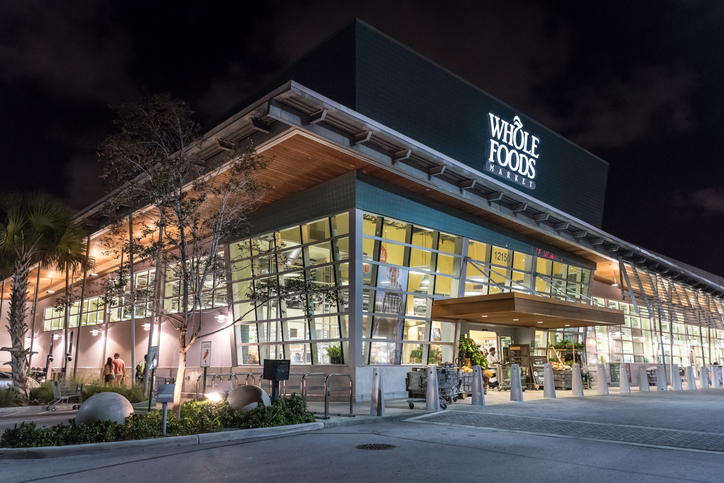Editor’s note: Paula Rosenblum is co-founder and managing partner at RSR Research, Miami. This is an edited version of a post that originally appeared under the title, “Whole Foods uses self-checkout, but Amazon Go is a no-go.”
A couple of weeks ago I stopped into my local Whole Foods Market to pick up some items. I was incredibly surprised to discover that all the express lanes had been pulled out and small self-checkout stations were replacing them.
It’s so out of character for Whole Foods Market. I’ve come to expect some level of personalized service when I go to the store, so it really was a head scratcher. I asked my friends and associates around the world and no one I know has ever seen self-checkout in the wild at Whole Foods Market. North Miami couldn’t possibly be their first test of the technology, could it?

At my Forbes editor’s suggestion, I sent a query over to the folks at Whole Foods Market and received the following response on its behalf:
“Whole Foods Market has installed self-checkout in a small number of our stores at the request of our customers. Team members continue to provide a personalized customer experience with full-service checkout alongside the self-checkout lanes which provide a faster option for customers on the go. No team member positions have been eliminated due to the addition of self-checkout.”
Of course, I don’t know anyone who requested self-checkout at Whole Foods, and I am not in any position to comment on whether or not team members have been eliminated as part of the implementation. That’s not the point. In my opinion, there are two more salient points to address:
- Assuming this becomes a trend at more stores, will it devalue the Whole Foods Market brand? Are we clear on what the company stands for anymore?
- And more importantly, if Amazon Go isn’t ready for the express lane at its own grocer, do we really think it’s ready for anyone?
 I’ve long said that my pragmatic head cannot wrap itself around the notion of cashierless checkout at any kind of scale. Having been a CIO and watched my support staff attempt to remotely troubleshoot problems at POS registers with in-store personnel, I simply cannot envision an in-store team managing the cameras, sensors and other technologies required to make cashierless checkout work. Even if the diagnostics are impeccable, I’ve had enough trouble getting someone to plug a new wire into a printer, what to speak of swap out sensors and cameras. I just don’t see it.
I’ve long said that my pragmatic head cannot wrap itself around the notion of cashierless checkout at any kind of scale. Having been a CIO and watched my support staff attempt to remotely troubleshoot problems at POS registers with in-store personnel, I simply cannot envision an in-store team managing the cameras, sensors and other technologies required to make cashierless checkout work. Even if the diagnostics are impeccable, I’ve had enough trouble getting someone to plug a new wire into a printer, what to speak of swap out sensors and cameras. I just don’t see it.
Then there’s the sheer cost of the thing. We just released our 2019 Store Benchmark Report (registration required to download) and for the third year in a row, we asked retailers, “If money was not an issue how would the following help make your stores more relevant?” Unsurprisingly, 68% of retailers cited “Getting new technologies rolled out to stores” as something that would make their stores very much more relevant. But a somewhat mind-boggling 56% also cited “cleaner stores” as something that would help them very much – just 1% fewer than “hiring better people.” How did this become a thing? When did it become OK to not have clean stores? And what does it do to a retailer’s brand when it has dirty bathrooms and selling floors? Ewwww (yeah, that’s the consumer in me talking).
We also asked, “Assuming money IS an issue, which THREE (3) are you mostly likely to tackle?” So we forced them to play lifeboat here. Pick your top three. Fifty-two percent said they would get new technologies rolled out to stores. That’s a good thing. But only 22% said they’d clean up their stores. Wow.
Further, when it came to the organizational inhibitors that keep them from taking advantage of the opportunities they see, 47% cited, “Stores already have too much going on; no capacity to add more projects” as a top-three internal challenge.
So, in that context, does anyone really think that the installation, care and feeding of cashierless technology is going anywhere anytime soon? I’m going to go way out on a limb here: I don’t.
Walmart gave it a go (no pun intended, really) and abandoned its cashierless checkout pilot. Walmart is not a dumb company. Other companies with traditional self-checkout in place are not rushing to switch to the newer version.
What you stand for
The long and the short of my learnings on this subject is this: don’t follow the crowd or believe everything you hear. Don’t chase the next bright shiny object. Decide who you are. Decide what you want your brand to stand for. Do not budge from that. Spend money on technologies and people that emphasize that. If you’re a premium brand, make sure you focus on great products and good service. If you’re a brand built around convenience, make sure everything is convenient, but doesn’t cost you an arm and a leg.
Retailers have already hit rock bottom on prices. It doesn’t help the industry to add expenses that don’t enhance profits and the customer experience. Think about what service means to you. Is it self-service? Assisted service? Buy the technologies that support that.
And don’t be afraid to make go, no-go decisions. Innovation matters but that innovation has to be relevant. And efficient.
